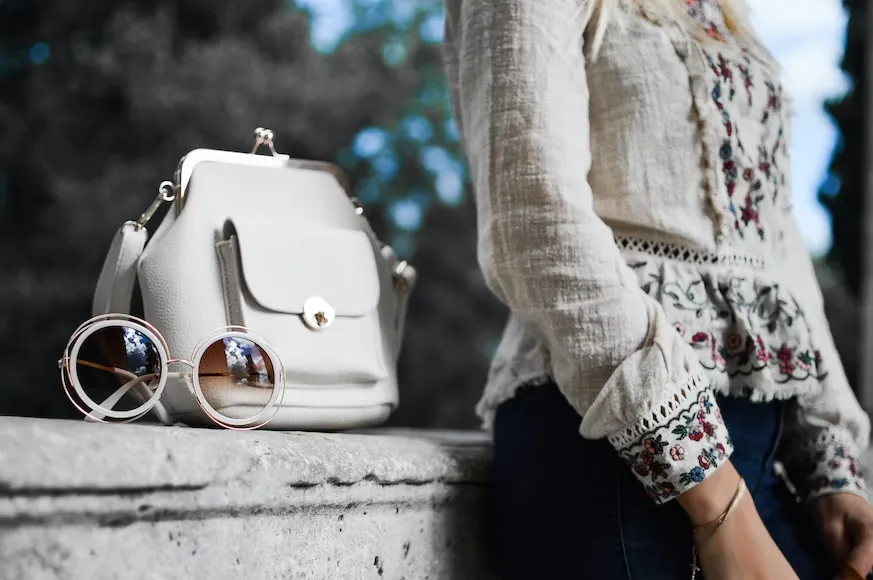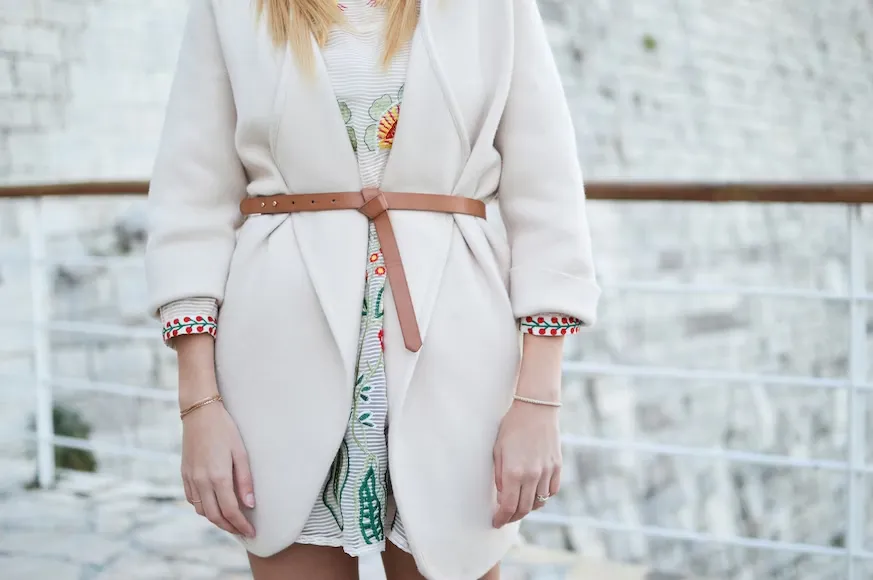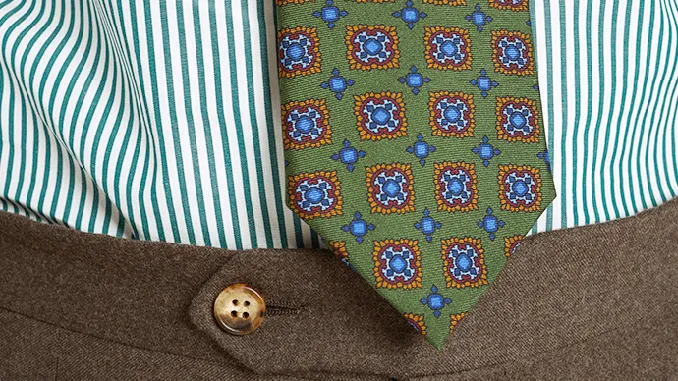The creators of fashionable clothing have always looked to the natural world for inspiration, and the graceful and attractive nature of foliage, and its associated blooms, is an obvious choice. This is partly due to the enormous range of flowers available. Initially designers were inspired only by the flowers they experienced in their immediate environments. This provided significant scope, especially when employing abstract as well as naturalistic interpretations. However, the advent of overseas exploration and the spread of information about new and exotic plants and flowers, meant that it was later possible to draw upon a far broader palette. Furthermore, imaginations, once sparked, have not been limited to the direct imitation of nature. Flights of fancy inspired by, but transcending, reality have resulted in examples of numerous fanciful blooms which sometimes bear no relation to real plants and flowers.
The enduring popularity of flowers goes deeper than the sheer numbers of different examples. There is something more significant about flowers themselves that keeps them relevant and endlessly appealing as a source of inspiration for dress. This is derived from their natural rather than man-made status. Though humans may control nature through the breeding of hybrids or new varieties, we still appreciate flowers as entities that are not of our own creation. Whether through belief in a Divine hand, a scientific understanding of the evolution of the natural world, or a combination of both, we marvel at the beauty of flowers. They have the power to appeal to our senses of sight, touch, smell and sometimes even taste. The way that flowers have the potential to grow in endlessly unpredictable ways, whilst still incorporating perfect symmetry in their patterns of petal and leaf formation, elicits in us a level of appreciation that few other aspects of our surroundings can muster.
Hand in hand with the appeal of nature goes the idea of flowers as ephemeral and short-lived. Their intrinsic connection to the passing of time and their growth during certain months of the year links flowers to the endless progress of the seasons. We associate their freshness and fragrance with the hopeful advent of Spring and Summer. The flower’s beauty is fleeting and fragile, and the fact that they bloom for only a limited time before they wilt and die makes us love flowers all the more fervently. It is no surprise that, long before photography, artists, textile designers and makers attempted to produce more permanent records and interpretations of flowers. Reproductions, whether in paint or textile forms, aim to capture the essence of the flowers’ vanishing beauty. Furthermore, appreciation of the delicacy, variety and transitory nature of flowers has led them to be harnessed in ways that transcend simple decoration; attractive and visually appealing as that may be. Throughout history flowers have taken on specific symbolic meanings. The importance of such symbolism to individuals and societies, whether heraldic, artistic or personal, has further led to their presence on textiles and dress.
Given their widespread appeal, it is not surprising that flowers are such a familiar aspect of clothing. Though we associate them more strongly with some eras, they remain a constant presence, whether in the background or at the forefront of fashion. It has been easy to find beautiful examples from a wide cross-section of historic periods to display here. In the interests of clarity and to aid interpretation, the garments and accessories in the exhibition have been divided into different thematic groups. These consist of items featuring woven flowers, printed flowers, embroidered flowers and sculpted flowers. Individual pieces which defy such categorisation have also been included, and of course the exhibition can simply be enjoyed as an immersive celebration of the beauty of flowers in dress.
All the garments displayed are drawn from the Olive Matthews Collection of Fashion which is housed here at Chertsey Museum.
Woven Flowers
 Examples of English 18th century gowns featuring beautiful flower patterns are seen nearby. Although the intricate designs may look like embroidery, they have in fact been incorporated into the silk during the weaving process. The patterns were produced using a draw loom; a large weaving device which was complicated and time-consuming to set up and operate. The resulting silk brocade fabric was a valuable textile which came second only to hand-worked embroidery in terms of cost and status.
Examples of English 18th century gowns featuring beautiful flower patterns are seen nearby. Although the intricate designs may look like embroidery, they have in fact been incorporated into the silk during the weaving process. The patterns were produced using a draw loom; a large weaving device which was complicated and time-consuming to set up and operate. The resulting silk brocade fabric was a valuable textile which came second only to hand-worked embroidery in terms of cost and status.
The late 1600s and the earliest years of the 1700s saw a mode for fantastical ‘bizarre’ designs in dress and furnishing fabrics. However, from the late 1720s fashions changed and patterns began to mimic the natural world. Large-scale floral sprays were wrought in bright colours. These wound their way up narrow widths of silk, many yards of which were used to produce the ever-widening skirts of the period. This trend is linked to broader cultural and scientific developments. Interest in the botanical world was flourishing. Exotic plant specimens from overseas were being discovered, recorded and categorised for the first time. Beautiful hand-coloured illustrations made their way into publications. These were appreciated alongside depictions of native species. There was also growing enthusiasm for garden design. This interest in horticulture and the natural world inspired artistic interpretations of real plants and flowers across the decorative arts, with impressive results in dress silks.
During the 1730s a novel technique in weaving enhanced the three-dimensionality of botanical silk designs, rendering them even more true to nature. First developed in the French silk-weaving city of Lyon, ‘Pointes Rentrés’ was a new type of silk shading produced by interlocking threads of different colours in a brickwork formation. It had the effect of blurring edges and emphasising light and shade. Spitalfields in East London, where many banished French Protestant weavers had settled, was also a silk weaving hub. Here the Pointes Rentrés technique was quickly adopted for the flowing, naturalistic floral patterns typical of English silks. The Spitalfields silk designer Anna Maria Garthwaite is particularly known for her work in this style.
The production of woven textiles was revolutionised during the early 1800s with the advent of the Jacquard loom. The use of punched cards to produce designs significantly sped up production. It consigned the cumbersome draw loom to the past and brought greater variety and affordability to silk manufacture. However, mechanised weaving has never fully managed to replicate the fluidity and elegance of 18th century hand-woven flowered silks.
Printed Flowers
 Whether striving to replicate natural floral patterns or depicting imaginary blooms, flowers have long been a popular choice for printed textile designs. They can range from the smallest sprigs in subtle shades to overblown bouquets and garlands in eye-catching colours. Even some abstract printed patterns were originally inspired by flower designs. Before their prolific use in the modern man-made textile industry, imprinted flower forms of all kinds traditionally added freshness and femininity to lighter-weight dress fabrics such as linen or cotton. Printed textiles have sometimes, but not always, been less costly to purchase than their woven or embroidered counterparts. They have been associated with the democratisation of fashion; bringing decorative interest to everyday dress. However, from the late 1780s to the early 1820s cottons (often featuring subtle floral prints) were elevated to greater fashionable heights and worn even on the smartest occasions.
Whether striving to replicate natural floral patterns or depicting imaginary blooms, flowers have long been a popular choice for printed textile designs. They can range from the smallest sprigs in subtle shades to overblown bouquets and garlands in eye-catching colours. Even some abstract printed patterns were originally inspired by flower designs. Before their prolific use in the modern man-made textile industry, imprinted flower forms of all kinds traditionally added freshness and femininity to lighter-weight dress fabrics such as linen or cotton. Printed textiles have sometimes, but not always, been less costly to purchase than their woven or embroidered counterparts. They have been associated with the democratisation of fashion; bringing decorative interest to everyday dress. However, from the late 1780s to the early 1820s cottons (often featuring subtle floral prints) were elevated to greater fashionable heights and worn even on the smartest occasions.
The East India Company began exporting plain and printed cottons to England during the 1630s, and from the beginning flowers and foliage featured. English printers and dyers soon began to make their own versions but imported prints still made up a significant proportion of the British market, particularly at the more costly end. Whether produced in Asia or at home, the resulting fabric was called ‘chintz’ (a name derived from the Hindi word chīnt which means spattered or stained). The dominant printing technique during much of the 18th century was block printing. This process, in which wooden blocks were carved with patterns, prepared with mordants and dyes and applied to the fabric by hand, was frequently enhanced by the addition of hand painting to add different colours. Called ‘pencilling’, this was a highly effective but very labour-intensive way of producing a design. The 18th century linen gown displayed nearby has been block printed and ‘pencilled’ in this way.
During the 1770s copper-plate printing produced a much more detailed, if monochromatic, result. Roller printing, utilising carved cylinders to apply designs at a greater rate, was first patented in 1785. Compared with the laborious block printing process, roller-printing was enormously productive. It became the most popular textile printing method until the advent of screen-printing in the 20th century. Screen printing uses negative stencil images. Dyes are forced through a fine mesh to produce designs. Many of the bold floral prints of the 1960s ‘Flower Power’ era were achieved using the screen printing technique.
Embroidered Flowers
 Embroidery lends itself beautifully to the depiction of flowers in dress. The intricacy and skill of the embroiderer’s art, which has the capacity to create detailed designs in a wide array of colours and textures, meant that for centuries this was the most exact way of producing decoration on textiles. The beauty of the natural world has always been an obvious source of inspiration for much embroidered work, and several different approaches to rendering flowers in both male and female dress are seen in the examples displayed. The beauty of the pieces produced, the materials used, and the time, knowledge and dexterity required for production has meant that hand embroidered fabrics have also traditionally been the costliest of all textiles. They tend to be reserved for the very best dress and have often been treasured and kept for posterity.
Embroidery lends itself beautifully to the depiction of flowers in dress. The intricacy and skill of the embroiderer’s art, which has the capacity to create detailed designs in a wide array of colours and textures, meant that for centuries this was the most exact way of producing decoration on textiles. The beauty of the natural world has always been an obvious source of inspiration for much embroidered work, and several different approaches to rendering flowers in both male and female dress are seen in the examples displayed. The beauty of the pieces produced, the materials used, and the time, knowledge and dexterity required for production has meant that hand embroidered fabrics have also traditionally been the costliest of all textiles. They tend to be reserved for the very best dress and have often been treasured and kept for posterity.
Hand embroidery was often carried out by trained professionals and used to decorate high-status textiles from at least as early as the Medieval period in western Europe. However, it has also been practised by amateur embroiderers for centuries. It was an aspect of the education of young girls and its importance increased during the 17th century and continued into the 19th. They were expected to be able to add decorative embellishments to household linen, shirts and accessories, and samplers were kept as a visual reference. When they reached adulthood, embroidery was also seen as an acceptable pastime for wealthier women, some of whom produced highly accomplished work.
Though often seen as a female occupation, trained male embroiderers traded at the top of the profession well into the 18th century. Only men were permitted to join the Worshipful Company of Broderers, and their work was found in the wardrobes of the elite. Embroiderers of both sexes hired out their services to smaller households or were employed by tailors. Many hands were involved in the creation of embroidered dress. First a tailor drew the shapes of the garment pieces onto the fabric. This would be mounted on a frame to keep it tight and easier to work. A professional pattern drawer then transferred a chosen embroidery design from paper. This was done by pricking the design through the paper and ‘pouncing’ a coloured dust through the holes to make tiny dots on the material. The pattern was then inked onto the fabric and the powder shaken off. Once the embroidery had been completed, the garment pieces were cut out and the article of clothing made up by the tailor. Though modern sewing machines can produce striking and accurate floral embroidery, there is still no substitute for the hand worked blooms that meander so delicately across these precious survivals.
Sculpted Flowers
 Dress and textile designers are not limited to flat representations of flowers. Some of the garments displayed are decorated with, or even resemble, three-dimensional flowers. There are pieces which incorporate artfully applied materials, such as the chiffon and velvet irises with glass dewdrops which embellish the skirt of the yellow ball gown nearby. In another approach, the cinnamon-coloured silk dinner gown features flower-heads sculpted from the same fabric as the dress and stitched to stand out from its surface. Bunches of imitation flowers have been added to hats, and garlands of orange blossom adorn the wedding gown which closes the exhibition.
Dress and textile designers are not limited to flat representations of flowers. Some of the garments displayed are decorated with, or even resemble, three-dimensional flowers. There are pieces which incorporate artfully applied materials, such as the chiffon and velvet irises with glass dewdrops which embellish the skirt of the yellow ball gown nearby. In another approach, the cinnamon-coloured silk dinner gown features flower-heads sculpted from the same fabric as the dress and stitched to stand out from its surface. Bunches of imitation flowers have been added to hats, and garlands of orange blossom adorn the wedding gown which closes the exhibition.
Perhaps the most striking example of a sculpted floral piece is the cyclamen pink evening gown by Bruce Oldfield from the late 1980s to early 1990s. The design has one shoulder strap which supports a petal-shaped panel, whilst the skirt is made up of five further ‘petal’ panels. The gown resembles a tulip flower, though the skilled construction and artful design means that it never strays into the realms of fancy dress. Other fashion houses have also successfully navigated this distinction in their work. Elsa Schiaparelli, Alexander McQueen and Comme des Garçons are all known for their impactful yet elegant sculpted floral creations.
The impulse to add greater texture and three-dimensionality to dress using floral decoration gathered momentum from the 1810s, when ball gowns and hairstyles were often festooned with swags of real or artificial flowers. This trend continued through the 19th and into the early 20th century, when day dress too could be enhanced by the addition of posies of flowers. This fashion echoed the generous use of artificial flowers to decorate hats and bonnets. Artificial flower making was a significant industry during the 19th century. The 1891 census recorded 4011 flower makers in London alone. The choice of flowers also held importance. The artificial orange blossom seen on the wedding gown displayed here is far more than decorative. The choice has meaning as part of the language of flowers (or Floriography) that gained credence during the Victorian age. Orange blossom symbolises eternal love and its popularity in relation to bridal dress increased after Queen Victoria wore an orange blossom headdress for her wedding to Prince Albert in 1840.





This article had me hooked! For further reading, check out: DISCOVER MORE. What are your thoughts?
You actually make it seem so easy with your presentation but I find this topic to be actually something that I think I would never understand. It seems too complex and extremely broad for me. I am looking forward for your next post, I will try to get the hang of it!